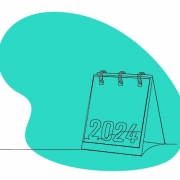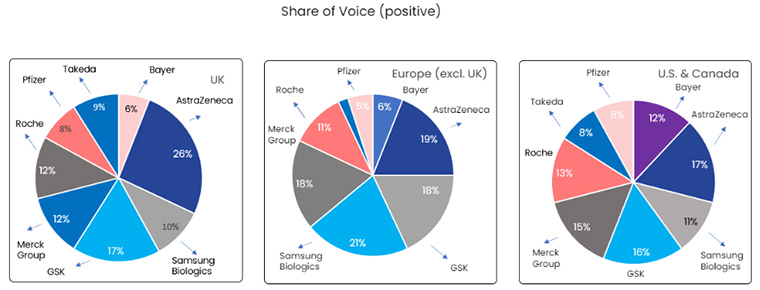Being ethical, sustainable, and honest were key to keeping client, consumer, and community loyalty throughout 2023. What should your focus be for 2024 in PR and comms?
Here are predictions from comms professionals for what you should expect in the year ahead. Get ready for collaboration, creativity, and keep in mind that the UK election season won’t be all bad…
1) Making the most of election season (even if it is a slog)
‘An election year always offers a lot of opportunity. Check out each of the party’s policies – what change is potentially coming round the corner for your organisation or clients? Make sure you’re horizon-scanning and planning accordingly.’
Sarah Waddington, director of Wadds Inc, founder of #FuturePRoof, and co-founder of Socially Mobile
‘This will open some interesting opportunities (beyond the Public Affairs remit and in line with the rules) for clients looking to increase brand awareness and be a central part of the media conversation and narrative when it comes to backing funding for their specific industries. Think infrastructure projects such as EV, telecoms, transport, as well as healthcare services i.e., mental health.’
Niki Hutchinson, founder and managing director at LarkHill PR
2) Collaborating with clients on content
‘I hope that 2024 sees more communications professionals work with customers to understand what messages resonate the most, and even co-create some campaigns, events, and content together. This will put an end to irrelevant messages that, at best, waste resources, and at worst, damage a brand’s reputation and customer loyalty.’
Sarah Danzl, CMO at Skillable
3) Being truthful
‘One of the biggest challenges is credibility and ensuring we are placing our clients in publications and on platforms which value truth and transparency. And although we seem to talk less about ‘fake news’, that challenge remains.
‘We have already seen, with Russell Brand’s large social media following and reach, along with Boris joining GB News, that alternative platforms create and groom loyal fanbases that are often less interested in fact, and instead value that feeling of community and belonging. As PRs, it’s important that we take note of their position and influence, while also remembering our duties to be truthful and to operate ethically.’
Victoria Moffatt, founder and managing director for LexRex Communications
4) Focusing on audiences
‘For any outcome to be achieved we need to persuade specific audience groups to take specific actions. Skills such as stakeholder mapping, behaviour science, prioritisation, and relationship building have become increasingly valuable and, when married to excellent planning and measurement, enable us to generate value and evidence it.’
Leigh Greenwood, founder and managing director of Evergreen PR
5) Becoming more results-driven
‘The evolution of PR into a more results critical model will continue. This perhaps being (as we are seeing) a 70/30 split between digital PR campaigns and brand PR – the former in the pursuit of increased organic keyword performance to drive much needed leads for clients. Basically, most businesses need double the sales leads to convert business as usual in this increasingly troubled market.’
Trevor Palmer, director/founder of Tank
6) Being purpose-driven, too
‘These days consumers are far more savvy when it comes to where they are spending their money and publications sometimes have a quota to cover a certain amount of sustainably responsible brands. This leaves a really big opportunity for purpose driven brands to succeed.’
Francesca Cullen and Rosie Lees, co-founders and directors of Nineteen94 Communications Agency
‘As many working in the comms industry know, the rules around the eco messaging companies can legitimately use to sell products and services is continually evolving. This is likely to continue to present sensitive and complex issues for brands keen to communicate green initiatives and innovations to target audiences, without falling foul of greenwashing claims, as we head into 2024.
‘For example, we expect to see a decline in the “big but difficult to prove” eco claims of the past – e.g. that a certain product or service is completely ‘carbon neutral’ – in favour of brands adopting a more honest and open dialog with audiences, that shows how they are improving things, as well as the work that still needs to be done.’
Alice Regester, CEO and co-founder of 33Seconds
‘In my opinion, this actually represents an opportunity for brands. The ones who are prepared to be transparent about their challenges – where they’ve fallen short and where they’ve needed to pivot – will be the ones who are seen as more authentic and trustworthy to their consumers, but will be the ones most likely to drive change – inspiring stakeholders and other brands.’
Lucy Newson, deputy managing director at Alfred
7) Using your brain
‘It’s time to focus on the most powerful tool PR and Marketing pros have – brain power. Hyper-personalisation is a key element within Industry 5.0 and we’re seeing it reflected in B2B buyer behaviour.
‘Be creative not bland, hook on to the ideas that are stimulating buyer behaviour, get strategic about your brand equity.’
Jamie Kightley, head of client Services for IBA International
8) Freshening-up content with video
‘PR that incorporates short form video will provide plenty of opportunity for more creative agencies and professionals. Younger audiences don’t want content dictated by centuries-old media companies. Fresh, original content via brands and organisations’ own channels will continue to dominate.’
Jane Whitham, director of Altitude PR
9) Increasing creativity when budgets decrease
‘Smart PR agencies will revel at the creative challenge of tighter briefs, smaller budgets and the need to, finally, nail campaign ROI. Most PR practitioners are problem solvers by nature, and it’s amazing what can be accomplished when you’re forced to think differently. Creative content is the perfect partner for PR. Today’s consumers of all ages are much more open to seeing creative content everywhere. We will see further integration of PR and social media in the years to come.’
Caroline Miller, founder and managing director at Indigo Pearl
10) Using human voices (that means case studies)
‘The rise in fake news, misinformation and the use of AI in comms is making audiences sceptical. As a result, they are turning to sources of information that feel authentic, relatable and human. This is a great opportunity for excellent PR – accurate storytelling that really resonates with the audience. Hard data adds to the feeling of trust, so a human voice coupled with decent data will be a winning combination. Putting the human voice at the centre of communications will be important, so thought leadership, expert content and influencers will be key players in 2024 strategies. So much so that Google is prioritising the proven experiences of individuals over branded content.’
Susannah Morgan, deputy managing director of Energy PR
11) But there’s no escape from AI just yet…
‘Since AI makes producing new content so much easier, content flooding is an unfortunate side-effect of this. Nevertheless, I believe that this repetitive content flooding our social channels will make us aware of the worthlessness of a great portion of the content we kind of got used to in the past and make us more discerning about the content we consume.’
Peter von Kageneck, DACH PR director for Life Size Media
‘The industry as a whole needs to acknowledge that the marriage of human creativity, strategic thinking, and data-driven AI insights can create an unprecedented and unrivalled level of impact when used correctly. Together, they will usher in a new era where PR is not just about communication – but more so understanding, influencing, and adapting to an evolving digital landscape.’
Sheridan Okey, head of digital PR at Tribera
‘News is cyclical and data can inform stories that have exceeded performance metrics in the past, and with AI further embraced in newsrooms we’ll see past content repurposed and reused throughout the year in line with regular trends and seasons. Cut-through for this type of activity will be much harder unless something really unique or compelling is offered, which could include reputable voices, rich in expertise or new supporting findings and data.’
Damian Summers, head of Digital PR at Impression
‘While for some this may be seen as “the robots taking our jobs”, it in fact provides opportunities for PR agencies to demonstrate their worth and how invaluable their insight is, by showing that we know our clients, have good relationships with the media and provide that crucial human element that AI just doesn’t have.’
Holly Daulby, managing director and founder of Honest Communications
12) Teamwork
‘Integration is a big one here. Utilising different services within PR campaigns is a great opportunity to maximise the reach of our stories, and allows clients to get more bang for their buck. Working across departments and cross-channel will be something agencies should be doing.’
Beth Turner, head of PR at ilk Agency
‘Harnessing the power of the team, working together, digging in, sharing the load and holding people’s hand to tackle the challenge together to me seems the best way to respond to the challenges ahead. Bring on 2024 – another year of challenge, change and opportunity.’
Rachel Roberts, CEO of spottydog Communications (part of Leopard Co)
‘Further integration between marketing channels. Budgets are tight and brands are looking for the maximum return from their investment. A multi-channel approach across PR, SEO, social and paid can support and increase results across all channels.’
Sarah Ross, account director for R&Co Communications
13) Shared experiences
‘I think we’ll continue to see the rise of community-driven experiences. The Barbie movie plus the Eras and Renaissance tours showed us that shared experiences are still top of people’s wishlists.’
Sarah Henderson, managing director of PrettyGreen Group and chief client officer
14) Equity
‘I, for one, am very much hoping that 2024 will be a year when the PR world starts to address equity and diversity. CIPR has made strides in this, and I am set to be the EDI Champion in the Southwest, but with figures showing that 9 in 10 UK practitioners are white, and 25% are privately educated—around four times higher than the UK national average—we need to do better.
‘We can no longer work in an industry full of offices that look like the cast of “Emily in Paris”, instead, we must make a commitment to a truly diverse workforce that reflects clients, campaigns, and stories.’
Natalie Trice, career coach, PR and media expert trainer
‘It’s no longer going to be acceptable for brands to simply give a small nod to their corporate values and responsibility to their communities. Consumers are more savvy and will actively call out brands whose messaging doesn’t seem sincere, and this can have a huge impact on the brands’ reputation.
‘It’s time for brands to be more consistent about where they stand on big social issues and be more authentic in their messaging. Next year, brands will need to start dedicating parts of their PR activity to show how they’re making a positive impact on the planet, their workers, and their communities.’
Gareth Hoyle, managing director for Coveragely
15) Zeroing in on Gen Z
‘Brands need to understand the Gen Z demographic, and target them through short form content and video, meaning that they need to be tapping into TikTok, and influencer marketing, and understanding how they engage. Taking time to learn this now will put your brand ahead of the curve come 2024.’
Hayley Knight, co-founder and communications director for BE YELLOW
16) Keeping our Google Overlords happy
‘Not only are trust signals such as customer reviews and testimonials, client lists, and industry accreditations important for today’s more cautious customers, but they’re also incredibly important to Google. Google is consistently trying to determine how trustworthy a brand’s website is in the same way that potential customers are in order to rank its search position. Third-party endorsement is going to be a requisite for brands in 2024.’
Sarah Woodhouse, director at AMBITIOUS PR
‘As the industry evolves, there’s a growing emphasis on what we call “search real estate”. Brands are investing in SEO and PR expertise to construct a digital presence that cultivates trust, thereby enhancing brand value and measurable conversation metrics.’
Lexi Mills, CEO of Shift6 Studios
17) Podcasting
‘If PR and communications professionals haven’t recognised the impact and reach of podcasts yet, they need to do this in 2024.’
Stephanie Mullins-Wiles, director of Bluesky Education
‘Multimedia content will also continue to grow over the next year, serving as an opportunity for agencies. According to Demand Sage, in 2023 there will be 464.7 million podcast listeners globally. This number is predicted to reach 504.9 million by 2024. Podcasts are no longer simply audio recordings, but video too, to provide visuals for listeners who are keen to consume content cinematically. According to Sprout Social, YouTube Shorts get 30 billion views daily from users around the globe; it is a platform not to be overlooked.’
Rachel Gilley, chief client officer at Clarity
18) Making use of insight tools
‘2024 has the opportunity to be the year where the PR industry really gets serious about listening to audiences as well as talking to them. The continued blurring of the lines between PR, digital, and social, and the myriad of tools both free and paid that we have at our disposal, mean the availability of insights to strengthen our work has never been greater.’
Ewan MacGill, associate director, consumer, at Frame
19) Optimism
‘Overwhelmingly, our research and audience profiling are showing that people want brands to spark joy, and make them smile. In the midst of multiple crises and distressing news cycles, people are looking to brands for a bit of escapism and lightness.
This needs to feel natural an authentic, as our audiences are more sensitive than ever to performative tactics. With this in mind, there will be an opportunity for brands that naturally fall in the spaces of humour, escapism and joy to truly amp up the fun, and shine bright in 2024.’
Dana Hanna, senior creative strategist for Ready10










 B Corp, for business, is what Fair Trade is to coffee. It means we are part of a group of change-makers committed to doing better and supporting a range of environmental and social issues. It goes beyond the idea of being ‘green’ or ‘eco’ and is about being transparent in your business – doing things the right way. Most importantly, this process has been independently verified by a dedicated team of analysts, so it’s not just something we have claimed ourselves, rather, something we have genuinely earnt off our own merit.
B Corp, for business, is what Fair Trade is to coffee. It means we are part of a group of change-makers committed to doing better and supporting a range of environmental and social issues. It goes beyond the idea of being ‘green’ or ‘eco’ and is about being transparent in your business – doing things the right way. Most importantly, this process has been independently verified by a dedicated team of analysts, so it’s not just something we have claimed ourselves, rather, something we have genuinely earnt off our own merit.














